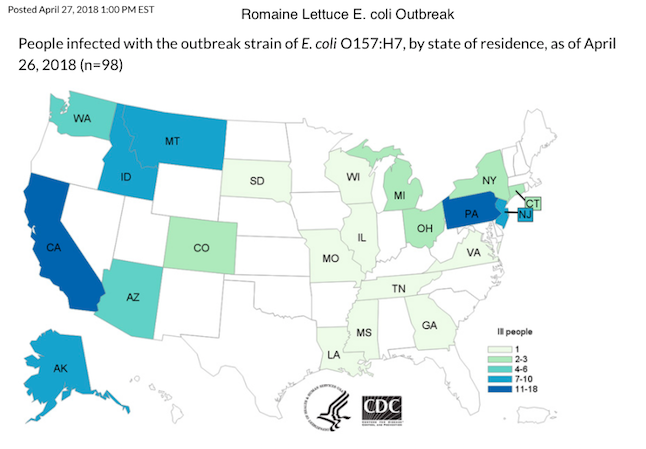Ten people who are among the 98 now sickened by romaine lettuce contaminated with E. coli have developed hemolytic uremic syndrome (HUS), a form of kidney failure, according to an outbreak update released by the Centers for Disease Control and Prevention (CDC) today. A total of 46 people have been hospitalized as a result of this outbreak which now includes cases in 22 states.
Since the last update two days ago, the outbreak has grown to include 14 more patients and three new states: Mississippi, Tennessee, and Wisconsin reporting one case each. Another seven of the cases in the newly reported total are from Alaska where an eight-person E.coli outbreak at Anvil Mountain Correctional Center in Nome was linked to the multi-state outbreak on April 21 but seven of the cases were not included in the multi-state outbreak total until today. One reason why may be the unsatisfying result of the U.S. Food and Drug Administration’s (FDA’s) traceback investigation of that outbreak.

Romaine E. coli Outbreak Investigation
Since the multi-state outbreak was identified about a month ago, the FDA has been trying to trace back the romaine lettuce from the clusters of illness reported to the farm or farms where it was grown to identify a common source of the outbreak. Initially, nearly all of the patients reported eating salads containing romaine lettuce at restaurants before they became ill. The restaurants, which the FDA and the CDC have not named, reported using chopped, bagged romaine to prepare the salads in question.
Using this information in their traceback efforts, FDA investigators were able to determine that the chopped, romaine lettuce originated in Yuma, AZ, where much of the nation’s romaine lettuce supply is grown from November until March. A consumer warning about chopped romaine lettuce from Yuma, AZ was issued and FDA investigators continued to try and drill down on where in the romaine supply chain the contamination occurred. Then Alaska reported the Anvil Mountain outbreak.
Unlike the case-patients in the lower 48, the Anvil Mountain patients all ate romaine lettuce that came from whole heads of romaine, a finding that seemed to hold an important key. But in today’s FDA investigation update, the agency said that while it was able to identify “Harrison Farms as the source of the whole-head romaine lettuce that made several people ill at a correctional facility in Alaska,” it has not been able to determine where in the supply chain (growing, harvesting, packaging or distribution) the contamination occurred. Further, the agency said, while the romaine responsible for the other 90 illnesses was grown in Yuma, AZ, it did not come from Harrison Farms and was supplied to restaurants and retailers through multiple processors, grower/shipper companies, and farms.
“All of the lettuce in question from Harrison Farms was harvested during March 5-16 and is past its 21-day shelf life. Because the growing season in the Yuma region is at its end, the farm is not growing any lettuce at this time,” the report stated.
Romaine shipments from all growers in Yuma stopped last week as romaine production made its annual shift from Arizona to California where 77 percent of our nation’s romaine is grown. Romaine now making its way to store shelves and restaurants should be coming from California, Florida or Mexico.
E. coli Food Poisoning Advice to Consumers
With 98 cases from 22 states, this is now the largest E. coli outbreak in the U.S. since 2006. The cases reported by state are as follows: Alaska (8), Arizona (5), California (16), Colorado (2), Connecticut (2), Georgia (1), Idaho (10), Illinois (1), Louisiana (1), Michigan (3), Mississippi (1), Missouri (1), Montana (8), New Jersey (7), New York (2), Ohio (3), Pennsylvania (18), South Dakota (1), Tennessee (1), Virginia (1), Washington (5), and Wisconsin (1).
As the number of illnesses in this outbreak has ballooned over the last few weeks, the advice to consumers has remained the same: don’t eat romaine lettuce that was grown in Yuma, AZ. The problem is that the state of origin does not appear on all forms of romaine. This caused frustration for consumers who are still seeing romaine on grocery store shelves and for some romaine producers who have issued statements saying their lettuce is not implicated in the outbreak.
HUS, which affects between 5 percent an 10 percent of E. coli patients, can be fatal. Those most at risk are young children, pregnant women, seniors and people with compromised immune systems. The CDC has not released any information about the patients who are battling the life-threatening condition.
HUS symptoms usually appear about a week after initial E. coli symptoms which include abdominal cramping and diarrhea that can bloody. They include:
- Fatigue
- Unexplained weakness
- Pale skin
- Decreased urination
- Unexplained bruises or bleeding
Anyone with symptoms of HUS needs immediate, emergency medical attention.
The E. coli lawyers at Pritzker Hageman represent clients nationwide who have been sickened by contaminated food. They have represented clients in nearly every major outbreak over the last 20 years including this one. If you or a loved one have been sickened by E. coli, contact them for a free, no-obligation consultation.